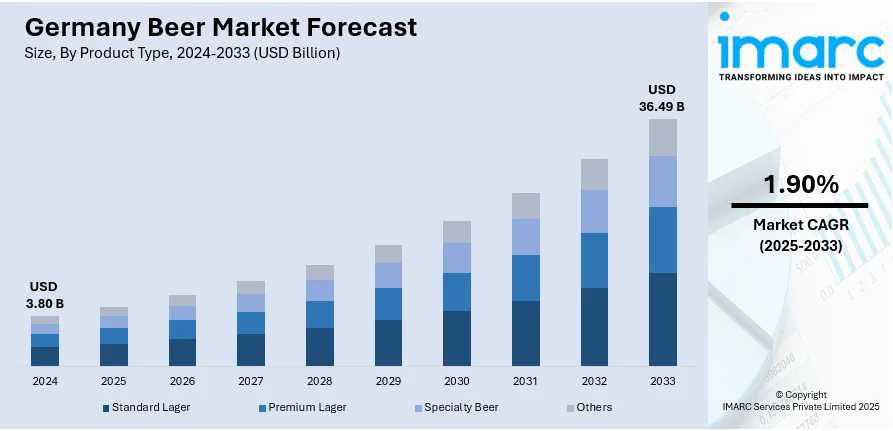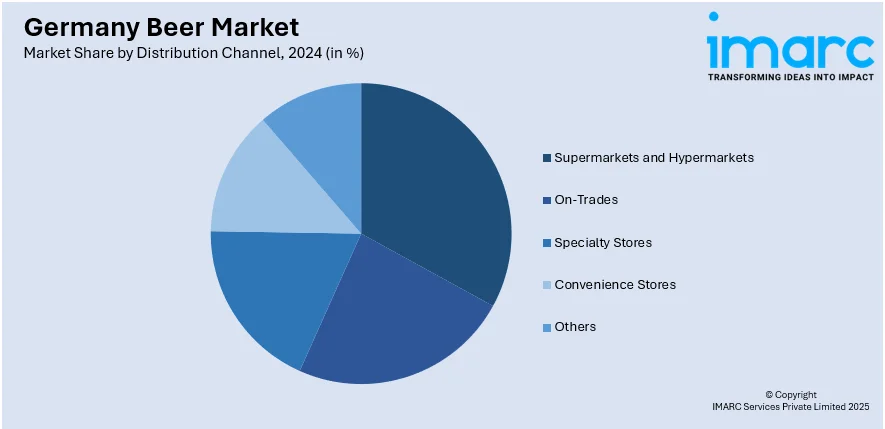
Germany Beer Market Size, Share, Trends and Forecast by, Product Type, Packaging, Production, Alcohol Content, Flavor, Distribution Channel and Region, 2025-2033
Germany Beer Market Overview:
The Germany beer market size reached USD 3.80 Billion in 2024. Looking forward, IMARC Group expects the market to reach USD 36.49 Billion by 2033, exhibiting a growth rate (CAGR) of 1.90% during 2025-2033. The market is propelled by a strong cultural heritage and tradition of beer consumption, increasing popularity of craft and specialty beers, rising health consciousness among consumers, growth of the beer tourism industry, and expanding distribution channels.
|
Report Attribute
|
Key Statistics
|
|---|---|
|
Base Year
|
2024 |
|
Forecast Years
|
2025-2033
|
|
Historical Years
|
2019-2024
|
| Market Size in 2024 | USD 3.80 Billion |
| Market Forecast in 2033 | USD 36.49 Billion |
| Market Growth Rate 2025-2033 | 1.90% |
Germany Beer Market Trends:
Strong Cultural Heritage and Tradition
Germany boasts a strong cultural heritage tied to beer, which is an integral part of the country's society. The nation is host to many beer festivals, most prominent of which is Oktoberfest in Munich and which hosts millions of tourists yearly. This strong cultural attachment encourages indigenous breweries and engenders a bonding of society based on beer drinking. Classic beer styles like Pilsner, Weizenbier, and Dunkel are revered and enjoyed, ensuring steady consumer demand. According to Gitnux, Pilsner accounts for around 50-60% of all beer sales in Germany, the most consumed beer in the market. Also, the Reinheitsgebot or German Beer Purity Law, enacted in 1516, upholds quality and genuineness in beer brewing. This legislation limits ingredients for brewing to water, hops, and barley, so the high quality trusted by consumers is maintained. German cultural popularity for beer makes it a fundamental component of parties, celebrations, and daily life, thereby driving market demand.

Growing Popularity of Craft and Specialty Beers
Craft beer is gaining popularity in Germany because of which consumers are looking for new experiences that provide subtle and complex tastes, thereby propelling the craft and specialty beer industry. Across the nation, there is an emergence of small independent breweries that are employing new brewing techniques and ingredients to create distinctive options for changing consumer tastes. This trend is also underpinned by younger consumers who appreciates authenticity and local goods, leading to a move away from mass-produced beers. The craft beer market appeals to hardcore enthusiasts and stimulates experimentation among social drinkers. Therefore, consumers are more likely to explore different beer styles, which results in overall growth in the industry. Additionally, sustainability and local sourcing are high on the agenda for most of the German craft breweries. This benefits ecologically minded consumers and introduces new possibilities to the marketplace, allowing the industry to expand.
Rising Health Consciousness Among Consumers
A major force behind the Germany beer market is growing health awareness among consumers. More people are opting for healthier lifestyles. Consequently, a comparatively new trend of low alcohol and no alcohol beer is gaining popularity. Non-alcoholic beers capture around 7% of the market for beer in Germany, reports Gitnux. This is especially appealing to consumers who desire the classic beer experience without the effects of alcohol, which is usually a negative at social gatherings. Because of this, brewers and craft manufacturers are introducing new product lines with non-alcoholic and low-calorie beers. This category is thriving as more people try to cut down on alcohol consumption but still want to enjoy the flavor of beer. Additionally, this trend is consistent with overall health movements, as consumers are starting to scrutinize ingredient panels more closely and choose drinks that are consistent with a healthy way of life.
Germany Beer Market Segmentation:
IMARC Group provides an analysis of the key trends in each segment of the market, along with forecasts at the region level for 2025-2033. Our report has categorized the market based on product type, packaging, production, alcohol content, flavor and distribution channel.
Product Type Insights:
- Standard Lager
- Premium Lager
- Specialty Beer
- Others
A detailed breakup and analysis of the market based on the product type have also been provided in the report. This includes standard lager, premium lager, specialty beer, and others.
Packaging Insights:
- Glass
- PET Bottle
- Metal Can
- Others
A detailed breakup and analysis of the market based on the packaging have also been provided in the report. This includes glass, PET bottle, metal can, others.
Production Insights:
- Macro-Brewery
- Micro-Brewery
- Others
The report has provided a detailed breakup and analysis of the market based on the production. This includes macro-brewery, micro-brewery, others.
Alcohol Content Insights:
- High
- Low
- Alcohol Free
A detailed breakup and analysis of the market based on the alcohol content have also been provided in the report. This includes high, low, and alcohol free.
Flavor Insights:
- Flavored
- Unflavored
The report has provided a detailed breakup and analysis of the market based on the flavor. This includes flavored, and unflavored.
Distribution Channel Insights:

- Supermarkets and Hypermarkets
- On-Trades
- Specialty Stores
- Convenience Stores
- Others
A detailed breakup and analysis of the market based on the distribution channel have also been provided in the report. This includes supermarkets and hypermarkets, on-trades, specialty stores, convenience stores, and others.
Regional Insights:
- Western Germany
- Southern Germany
- Eastern Germany
- Northern Germany
The report has also provided a comprehensive analysis of all the major regional markets, which include Western, Southern, Eastern, and Northern Germany.
Competitive Landscape:
The market research report has also provided a comprehensive analysis of the competitive landscape. Competitive analysis such as market structure, key player positioning, top winning strategies, competitive dashboard, and company evaluation quadrant has been covered in the report. Also, detailed profiles of all major companies have been provided.
Germany Beer Market News:
- 24 February 2024: Augustiner Bräu Wagner KG, Munich's oldest privately owned brewery, has entered into a trade agreement with James Clay & Sons, a specialist UK beer. Through this agreement, James Clay & Sons will have an exclusive right to import and distribute Augustiner products in the UK.
- 11 September 2023: German brewer Bitburger signed a sponsorship deal with UEFA EURO 2024 as the official national partner of the championship. Under the partnership agreement, Bitburger brands will exclusively be available in all stadiums and official events in the host cities.
Germany Beer Market Report Coverage:
| Report Features | Details |
|---|---|
| Base Year of the Analysis | 2024 |
| Historical Period | 2019-2024 |
| Forecast Period | 2025-2033 |
| Units | Billion USD |
| Scope of the Report |
Exploration of Historical Trends and Market Outlook, Industry Catalysts and Challenges, Segment-Wise Historical and Future Market Assessment:
|
| Product Types Covered | Standard Lager, Premium Lager, Specialty Beer, Others |
| Packaging Covered | Glass, PET Bottle, Metal Can, Others |
| Production Covered | Macro-Brewery, Micro-Brewery, Others |
| Alcohol Content Covered | High, Low, Alcohol Free |
| Flavor Covered | Flavored, Unflavored |
| Distribution Channel Covered | Supermarkets and Hypermarkets, On-Trades, Specialty Stores, Convenience Stores, Others |
| Regions Covered | Western Germany, Southern Germany, Eastern Germany, Northern Germany |
| Customization Scope | 10% Free Customization |
| Post-Sale Analyst Support | 10-12 Weeks |
| Delivery Format | PDF and Excel through Email (We can also provide the editable version of the report in PPT/Word format on special request) |
Key Questions Answered in This Report:
- How has the Germany beer market performed so far and how will it perform in the coming years?
- What is the breakup of the Germany beer market on the basis of product type?
- What is the breakup of the Germany beer market on the basis of packaging?
- What is the breakup of the Germany beer market on the basis of production?
- What is the breakup of the Germany beer market on the basis of alcohol content?
- What is the breakup of the Germany beer market on the basis of flavor?
- What is the breakup of the Germany beer market on the basis of distribution channel?
- What is the breakup of the Germany beer market on the basis of region?
- What are the various stages in the value chain of the Germany beer market?
- What are the key driving factors and challenges in the Germany beer?
- What is the structure of the Germany beer market and who are the key players?
- What is the degree of competition in the Germany beer market?
Key Benefits for Stakeholders:
- IMARC’s industry report offers a comprehensive quantitative analysis of various market segments, historical and current market trends, market forecasts, and dynamics of the Germany beer market from 2019-2033.
- The research report provides the latest information on the market drivers, challenges, and opportunities in the Germany beer market.
- Porter's five forces analysis assist stakeholders in assessing the impact of new entrants, competitive rivalry, supplier power, buyer power, and the threat of substitution. It helps stakeholders to analyze the level of competition within the Germany beer industry and its attractiveness.
- Competitive landscape allows stakeholders to understand their competitive environment and provides an insight into the current positions of key players in the market.
Need more help?
- Speak to our experienced analysts for insights on the current market scenarios.
- Include additional segments and countries to customize the report as per your requirement.
- Gain an unparalleled competitive advantage in your domain by understanding how to utilize the report and positively impacting your operations and revenue.
- For further assistance, please connect with our analysts.
 Inquire Before Buying
Inquire Before Buying
 Speak to an Analyst
Speak to an Analyst
 Request Brochure
Request Brochure
 Request Customization
Request Customization




.webp)




.webp)












